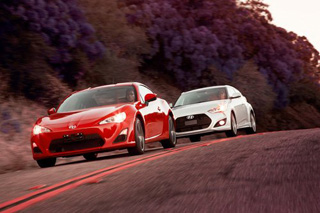Hyundai Veloster test drive since 2011 hatchback
Hyundai Veloster test drive. Economical and modern
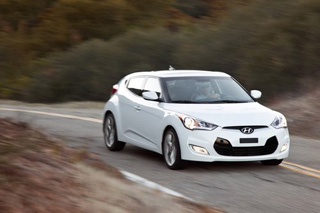 Hyundai flatly can say what Veloster means. There are a lot of assumptions on this topic, says the representative of Hyundai. But in fact, this is just a suitable name for this car that we came up with.
Hyundai flatly can say what Veloster means. There are a lot of assumptions on this topic, says the representative of Hyundai. But in fact, this is just a suitable name for this car that we came up with. It's like with the third door, he continues. We leave the right to interpret for buyers.
Well, fine. We will think about it.
Hyundai Veloster is an incredibly stylish and playful hatchback, so the name Veloster may well come from the word Velocity, which, in accordance with the data of the explanatory dictionary of English, means not slow.
True, when accelerating from zero to 96 km/h (60 miles/hour) in 10.2 seconds and quotas in 17.4 seconds (speed at the finish of 130.6 km/h), Veloster is categorically slow.
Not fast
Not that Hyundai has ever stated that Veloster will be the hottest hatch in the world. On the contrary, the Korean automaker boasted of the expected expenditure of 8.4 liters per 100 km of run in urban mode/ 5.8 liters of the highway/ 7.3 liters in mixed mode and the installation of a standard six -speed mechanical gearbox unambiguously indicates that Velos It is positioned as an economical car, not an uncompromising sports car. Nevertheless, Veloster's appearance is such that it looks fast, which is very contributed to a bifurcated exhaust.
The reality is that this 1 278-kilogram front-wheel drive car with an atmospheric 1.6-liter inherent four-cylinder engine cannot be called the embodiment of the speed formula, even despite the presence of a direct fuel injection, double valves located on top, and the gas distribution phase change system. Especially not in his favor, power is indicated, which is only 138 hp. for 6,300 engine speeds per minute and 166 Nm of torque at the mark of 4,850 r./min.
The Veloster who arrived at our test was also equipped with an optional (cost of $ 1,250) with a six -speed double clutch transmission (DCT) the first in the entire Hyundai history. Equipped DCT Veloster does not know how to raise momentum for a quick start, he does not have enough traction at low speeds, and therefore his destiny is slowly cowardly outside the stream. Hyundai Accent 2012 (the first car of a 1.6 -liter GDI Gamma engine) turned out to be slightly worse than his more sports brother, as it exchanges the first hundred in 9.8 seconds.
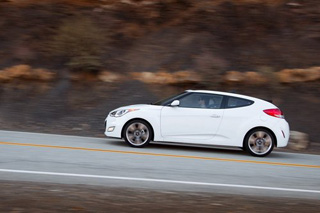 For comparison, the Honda CR-Z with a mechanical gearbox accelerates to 96 km/h in 8.8 seconds, the version with the variator does this in 9.2 seconds. Mini claim that their 121-horsepower Cooper Clubman with a six-speed gearbox accelerates from a place to hundreds in 8.9 seconds, and with a six-speed automatic in 10.2 seconds, like Veloster. Scion TC The most nimble in this group, the 180-horsepower 2.5-liter four-cylinder engine accelerates it to 96 km/h in 7.3 seconds (transmission six-speed mechanics).
For comparison, the Honda CR-Z with a mechanical gearbox accelerates to 96 km/h in 8.8 seconds, the version with the variator does this in 9.2 seconds. Mini claim that their 121-horsepower Cooper Clubman with a six-speed gearbox accelerates from a place to hundreds in 8.9 seconds, and with a six-speed automatic in 10.2 seconds, like Veloster. Scion TC The most nimble in this group, the 180-horsepower 2.5-liter four-cylinder engine accelerates it to 96 km/h in 7.3 seconds (transmission six-speed mechanics). The Huyndai Velosteer 2012 four -cylinder engine operates smoothly and quietly, especially on the highway, at a speed of 110 km/h, which corresponds to 2,500 motor speeds per minute. Of course, this small motor does not develop special traction at such revolutions, which means that to accelerate, you will have to go down at once to two gears at once, if such a thought has ever come to your mind. Want to overtake that on the 18th casting? Click twice with this small switch on the left under the wheel. Switching is quite fast and always smooth. Minus DCT does not allow the engine to unwind to the cut -off.
Let's talk
There is nothing particularly in the design of Veloster suspension. In front, MacPherson racks and two -pipe shock absorbers, a longitudinal beam and single -pipe shock absorbers are used. True, the Hyundai suspension settings have chosen rather tough, and the body also turned out to be tough. Therefore, on Slalom, Veloster demonstrated a pretty good result of 107.3 km/h. And this is despite (and not because of) very unkempt all-season tires Kumho Solus KH25 of the size of 215/40 R18. Because of them, Veloster was able to develop only 0.81G in the test for the lateral acceleration test. The steering rack with an electric power amplifier makes it quite understandable, but a little light to our taste.
The well -tuned Hyundai Velostek 2012 suspension is even better behaved on the road, taking the cranes of the body to a minimum. Of course, there is some insufficient rotation, but it is very easy to control the dosing of the force on the right pedal. One has only to let go of the gas pedal, and the front wheels immediately gain a clutch with the road. The back is very stable, only in the center of turn on significant unevenness sometimes demonstrates behavior typical of cars with a beam. The disadvantage of the hard suspension on the springs is that on the highway the car is much tougher than you can expect from a representative of the economy class.
All this makes us think: an economical inexpensive hatchback, slow to disgrace, but with the controllability of the athlete. All this resembles Honda CRX mid-1980s. In December 1983, the Road & Track issue published an article on Honda Civic CRX 1.5 on a mechanical five -speed mechanics, which developed an excellent speed on a slalom of 107.4 km/h, and 0.81G in a turn. That CRX weighing 870 kg accelerated from a place to hundreds in 10.1 seconds, and a quarter of a mile passed in 17.6 seconds, accelerating at the finish of up to 126 km/h. It looks frighteningly. The approximate CRX consumption was supposed to be about 6.7 l/100 km of run in normal mode. According to our estimates, the Veloster consumption was an average of 8.8 liters per 100 km, and on the highway with the lifting and descent it ate 10.2 liters.
Velosteer front ventilated ventilated 11-inch brake discs (complete with single-piston sliding calipers) and 10.3-inch rear whole discs showed a fairly good result in emergency braking tests of 36.8 meters. It is not surprising that these brakes, which looked inappropriately miniature inside the optional 18-inch cast discs, were slightly overheated on the descent, the pedal became sluggish, while we had diminished confidence. In other situations, the pedal is solid and confident.
 High style
High style On the Hyundai Veloster 2012 road looks like no one else. But in order to appreciate the efforts of Hyundai in this area, you need to dig a little deeper than the black roof, bloated arches and exhaust pipes located in the center. Go a little closer and carefully consider the rear lights of the exquisite shape, study all the details of the design of the optics, both the front and the rear. The only missing in design, in our opinion, is fake air intakes on the hood. Veloster is highlighted even more among such near -sports hatchbacks his third door. The bottom line is that at first glance it can not be seen at all. Due to the fact that the loops are deployed forward, it can be opened regardless of the front door, unlike Mazda RX-8 and Mini Cooper Clubman.
The third door of Veloster greatly facilitates access to two rear seats. Although the low roof and a small stroke of the loop turn the landing there an adult into a circus acrobatic number.
The starting price of the Hyundai Veloster in the USA $ 18,060 (including the cost of delivery to the interior of your dealer) for a car with a six -speed manual gearbox could well imply its cheapness, but the design of the salon speaks of the opposite. The dominant role here is assigned similar to the shield of the central console, where the engine start button and a 7-inch multifunction sensory display, and huge door handles in the industrial style are located. However, you have to pay for the style, and this functionality. These massive door handles partially block the glass windows control buttons from the driver's side, as well as because of them, the pockets on the door are so far and so difficult to get to them.
Front sports seats provide excellent side support in combination with comfort, however, drivers with high growth would like to be attached below, so that there is more space above their heads, especially for configuration with a panoramic roof (part of the Style options worth $ 2,000).
Despite the fact that in the cabin the textures strict to the touch prevail, it still looks stunning due to the correct choice of the method of processing surfaces.
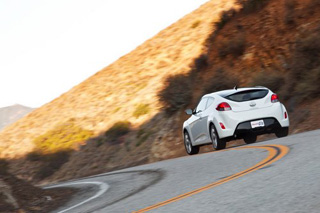 In the end ... an economical car
In the end ... an economical car OK, the speed when accelerating in a straight Hyundai Veloster, in truth, does not get it. And in this sense, he does not reach his pretentious exquisite appearance. And, yes, the 28-year-old Honda CRX will easily make it at a traffic light.
Those who like the dynamics and speed are better to wait for the release of Veloster Turbo (capacity of 208 hp), the debut presentation of which took place as part of the Detroit car dealership, and which will go on sale in the summer of 2012.
But like the CRX of the mid-1980s, the Hyundai Veloster with an atmospheric engine offers the controllability of a sports car in combination with the consumption of an economical car. And to ride it just as exciting.
In general, at Veloster we see a unique third door and a practical hatchback configuration, four almost full -fledged seats, a low basic cost and a thoroughly thought -out inimitable body design, which cannot ignore customers who do not chase high speed.
Apparently, the drag racing is not for everyone.
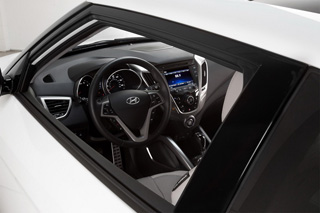
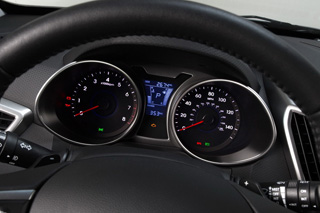
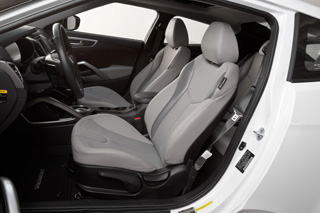
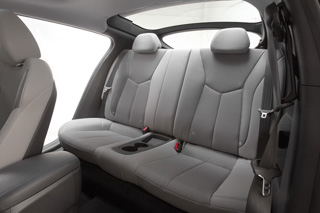
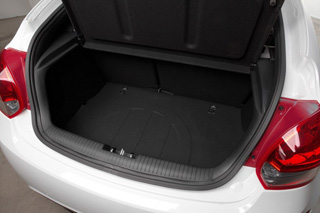
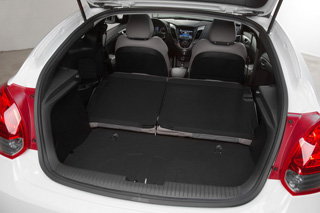
Source: Insideline

.jpg)
.jpg)
.jpg)
.jpg)
.jpg)



